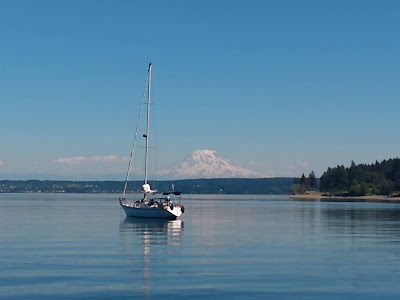This post includes a bunch of boat maintenance stuff. Feel free to skip if this sounds boring.
In the last blog post, we wrote about keeping social distance while cruising--avoiding marinas, keeping systems maintained and safe, etc. But what about if social distancing isn't possible? What if we absolutely need to pull in and haul out?
We haul De Novo out every other year to work on her hull; since we did this in 2019, we weren't scheduled for another year. In the off-years, we hire Double J Diving to change our zinc anodes and scrub growth off in the water.
Seacocks:
However, we grew uneasy about a questionable seacock we wished we replaced last haul out. And we can't replace seacocks when the boat's in the water. Despite exercising (opening and closing several times) each valve every few months, we recently found this one wouldn't close. Not good.
Fortunately, we have some safeguards to prevent our boat filling up with saltwater if the hose attached to the valve were to fail as well. We've tied appropriate-sized plugs to each seacock so we don't have to fumble for the right one in an emergency. We have three bilge pumps: two automatic and one manual. However, two of those four safeguards require we're actually at the boat at all times. In the end, it just made sense to defy the stay-at-home order and haul out this summer. To plan ahead, we decided to replace two seacocks: the one in question and another that could've failed in a few years. Now all seven thru-hulls have solid, structurally sound bronze sea cocks, and we won't need to worry.
In the interest of cost and safety, we chose Swantown Boatworks in Olympia and tacked it on to the end of our longer summer trip. For those of us who prefer to save money and do most of our own work, it's a much cheaper option than anywhere in Seattle. To prevent virus transmission, the yard spaced boats further apart than normal, used masks, and communicated all details by phone rather than in person.
Propeller:
We don't think we did a sufficient job with the propeller last year. After reading about it more, we think we didn't sand it smooth enough and apply enough coats of primer or paint. Due to our user-error, we can't yet determine if Primacon primer and Trilux 33 work, so we're giving them both another shot. If it looks poor on our next dive, we'll upgrade to Propspeed when we haul out again in two years. We'll let you know.
While we didn't see growth or barnacles,
the paint already peeled since last year's application.
Sanding it thoroughly with 80, 120, and then 400 grit.
This combination eventually allowed for a smooth finish.
Spraying three coats of Primacon, sanding with 400 between coats
All done! Four coats of Trilux 33 with light 1000-grit sanding as needed.
Super smooth.
Since we were hauling out anyway, we decided to lightly vacuum sand and paint two more coats of Seahawk antifouling on the bottom, wax the waterline, and replace zinc anodes--all tasks we would have done next year. This way, we can save our next haul out until summer 2022 (fingers crossed!).
Our Novi, ready for new adventures









































